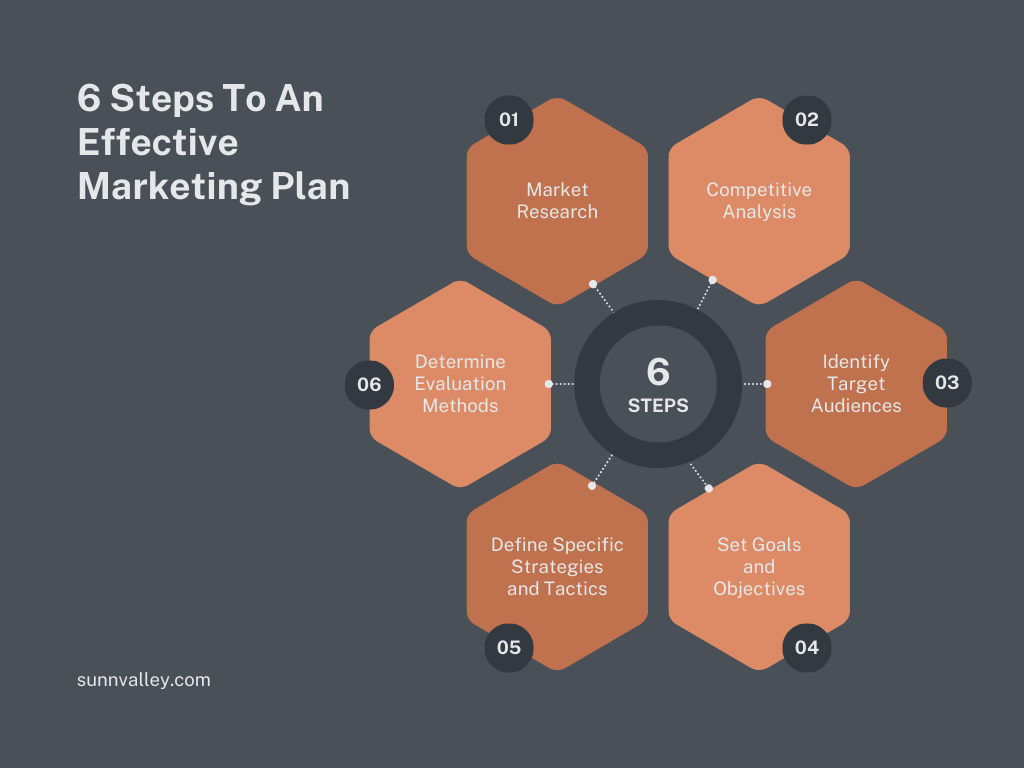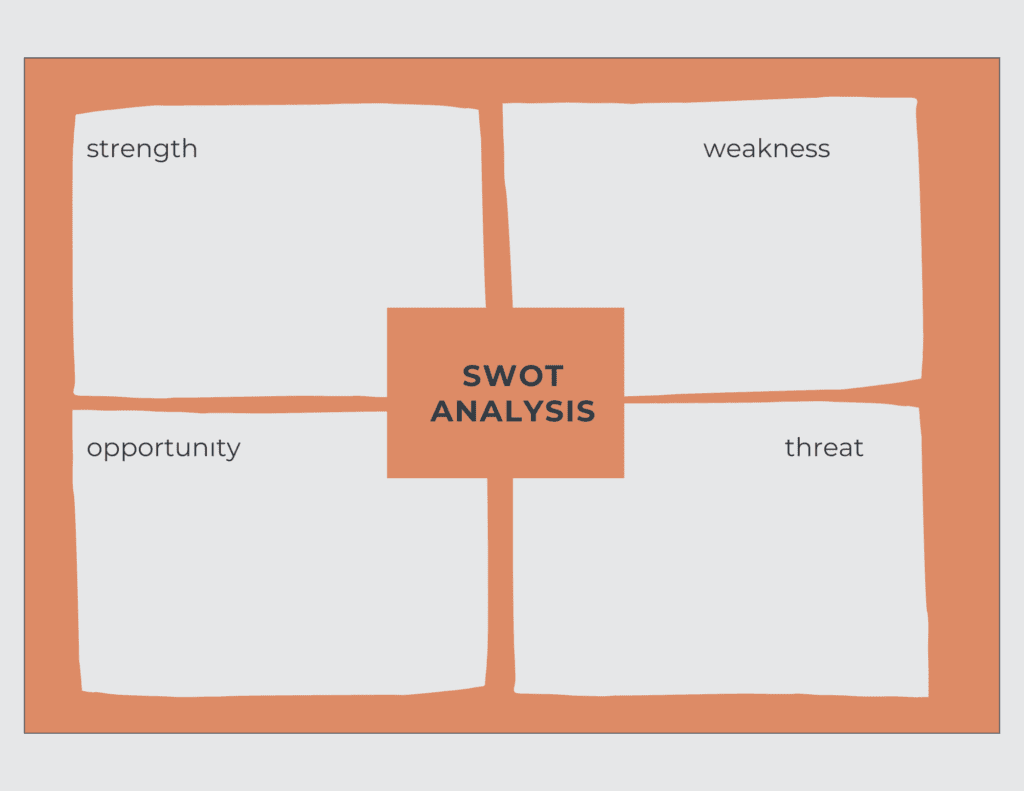In the fast-paced and ever-evolving landscape of business, a well-crafted marketing plan serves as the compass guiding your journey to success. Whether you’re launching a new venture or seeking to revitalize an existing business, mastering the art of marketing is paramount. Let’s delve into a comprehensive 6-step marketing plan that can be applied to any business, unraveling the intricacies of each step.

Step 1: How to do Market Research
Before embarking on any marketing venture, a solid understanding of the market is essential. Market research is not a one-size-fits-all process; it requires tailored strategies to unveil insights unique to your industry. Here’s how to go about it:
Online Presence Analysis: Start by analyzing your online presence. Dive into website analytics, social media metrics, and other digital touchpoints to gauge your current standing. Online Tool
Customer Surveys and Feedback: Connect with your existing customer base through surveys and feedback forms. Understand their needs, preferences, and pain points to refine your offerings.
Industry Reports and Trends: Stay ahead of the curve by immersing yourself in industry reports and staying abreast of emerging trends. This will provide valuable insights into the direction your market is heading.
By thoroughly researching your market, you gain a strategic advantage, allowing you to tailor your products or services to meet the ever-evolving needs of your audience.
Step 2: How to do Competitive Analysis
To thrive in a competitive landscape, understanding your rivals is indispensable. Competitive analysis arms you with the knowledge to position your business effectively. Here’s a roadmap for this critical step:
Identify Competitors: Compile a list of your primary competitors. Look beyond direct competitors to those occupying adjacent spaces in your industry.
SWOT Analysis: Perform a SWOT analysis (Strengths, Weaknesses, Opportunities, Threats) for both your business and competitors. This comparative analysis reveals areas for improvement and opportunities for differentiation.

Differentiation Strategy: Identify what makes your business unique. Your Unique Selling Proposition (USP) should resonate with your target audience and set you apart from the competition.
By dissecting your competition, you gain valuable insights to refine your business strategy, capitalize on opportunities, and fortify against potential threats.
Step 3: Identify Target Audiences
Knowing your audience is fundamental to delivering products or services that meet their needs. Here’s how to pinpoint and understand your target audience:
Demographic Analysis: Define the key demographics of your ideal customers, including age, gender, location, income level, and occupation.
Psychographic Understanding: Delve into the psychographics of your audience – their values, interests, lifestyles, and behaviors. This helps create more targeted and resonant marketing messages.
Feedback and Engagement: Actively seek feedback from your current customer base. Monitor social media channels for conversations about your brand. Engage with your audience to foster a deeper understanding of their needs.
Crafting buyer personas based on this information allows you to tailor your marketing efforts to a more receptive and engaged audience.
Step 4: Set Goals and Objectives
Goals and objectives provide the roadmap for your marketing journey. They need to be specific, measurable, achievable, relevant, and time-bound (SMART). Here’s how to set them effectively:
Clarify Your Vision: Clearly articulate your business objectives and vision. What do you aim to achieve with your marketing efforts?
Break Down Into Objectives: Break down your overarching goals into smaller, achievable objectives. These could include expanding your customer base, increasing revenue, or launching a new product.
Align with Business Strategy: Ensure that your marketing goals align with your overall business strategy. Your marketing efforts should be a cohesive part of your business’s growth plan.
Setting clear goals and objectives provides your team with a sense of direction, ensuring everyone is working towards a common purpose.
Step 5: Define Specific Strategies and Tactics
With goals in place, it’s time to develop a comprehensive strategy. This step involves choosing the most effective channels and crafting compelling messages to reach your target audience. Here’s a breakdown:
Channel Selection: Identify the most effective marketing channels for your business. This could include digital platforms, traditional advertising, content marketing, or a combination of these.
Message Crafting: Develop a cohesive and compelling message that aligns with your brand and resonates with your target audience. Consistency across all channels is key.
Integration of Offline and Online Tactics: Create a seamless experience for your audience by integrating both online and offline marketing tactics. This could involve hosting events, leveraging social media, and optimizing your website for search engines.
By strategically deploying your resources across various channels, you maximize your reach and impact, ensuring your message reaches your intended audience.
Step 6: Determine Evaluation Methods
The final step in your marketing plan is to establish key performance indicators (KPIs) and methods to evaluate your success. Here’s how to gauge the effectiveness of your marketing efforts:
Track Key Metrics: Identify and track key metrics that align with your goals. This could include website traffic, conversion rates, customer acquisition costs, and social media engagement.
Customer Feedback and Satisfaction Surveys: Actively seek feedback from your customers through surveys and other feedback mechanisms. Understand their satisfaction levels and areas for improvement.
Regular Analysis and Adaptation: Regularly analyze the gathered data to assess the performance of your marketing strategies. Be prepared to adapt and refine your approach based on the insights gained.
By consistently evaluating your marketing performance, you ensure that your marketing strategies remain effective and aligned with your business objectives.
In conclusion, a well-structured marketing plan is a dynamic tool that adapts to the changing landscape of your business and industry. By following these six essential steps, you create a framework that not only propels your business forward but also allows for continuous improvement and adaptation in an ever-evolving market. Remember, success is not just about where you are; it’s about where you’re headed. Craft your marketing plan with foresight, diligence, and a keen understanding of your audience, and watch your business soar to new heights.

